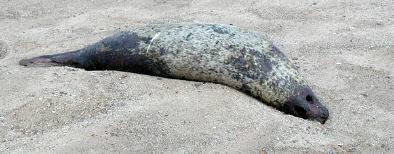20 August 2002 - It was confirmed today that a body of a seal washed up on the Gibraltar Point Reserve had died from the Distemper virus.
A seal suffering from Phocine Distemper Virus awaits treatment in the Norfolk RSPCA wildlife hospital, 14 August 2002. The deadly virus that has killed 3,000 seals off Northern Europe has spread to the Wash area with 7 cases now confirmed
In 1988, an outbreak of Phocine Distemper Virus (PDV) caused the death of 17-18000 common seals (Phoca vitulina) and 3-400 grey seals (Halichoerus grypus). The disease was first recorded in infected seals located around the island of Anholt (Denmark) and spread over several months to infect seals in the North Sea, Wadden Sea, Baltic and Irish Sea. Considerable scientific research was conducted to establish the cause of the outbreak and its impact on UK and European seals. Within the UK, the greatest declines in common seal populations occurred in the wash and the Moray Firth.
Over the last few months, a virus virtually identical to the 1988 strain of PDV has again been associated with the deaths of common seals, starting in the same place, Anholt.
Drawing on lessons that have been learned during the last outbreak, DEFRA is helping voluntary organisation prepare for the outbreak of PDV. They are working with a network of voluntary organisations to ensure that seals are assessed and appropriately treated.
December 2002 - The number of dead seals has declined and it is thought that the epedemic is now over, having naturally run its course. Some 3,000 bodies have been washed up on the Lincolnshire, Norfolk and Suffolk coasts and this is considered to represent about half the seal population in the "Greater Wash" area.





